Methodology for the Assessment of Multi-Hazard Risk in Urban Homogenous Zones
Abstract
:1. Introduction
2. Methodology
2.1. Multi-Criteria Analysis and Decision-Making Approach to Risk Assessment
2.2. Risk Assessment of Buildings
- -
- Flood vulnerability index for buildings,
- -
- Extreme coastal waves vulnerability index for buildings,
- -
- Seismic vulnerability index for buildings,
- -
- Flood hazard,
- -
- Extreme coastal waves hazard,
- -
- Seismic hazard.
2.3. Risk Assessment of Homogenous Zones
3. Results
3.1. Single-Hazard Risk Asssessment of Homogenous Zones
- -
- Seismic hazard—PGA,
- -
- Buildings’ seismic vulnerability,
- -
- Geology,
- -
- Communal infrastructure—electricity supply,
- -
- Communal infrastructure—water supply and drainage,
- -
- Road network,
- -
- Construction density (distance between buildings),
- -
- Inhabitation density,
- -
- Importance factor (public, school, etc.),
- -
- Historical buildings.
3.2. Multi-Hazard Risk Asssessment of Homogenous Zones
4. Conclusions
Author Contributions
Funding
Institutional Review Board Statement
Informed Consent Statement
Data Availability Statement
Acknowledgments
Conflicts of Interest
References
- Zerger, A. Examining GIS decision utility for natural hazard risk modelling. Environ. Model. Softw. 2002, 17, 287–294. [Google Scholar] [CrossRef]
- Yum, S.-G.; Son, K.; Son, S.; Kim, J.-M. Identifying Risk Indicators for Natural Hazard-Related Power Outages as a Component of Risk Assessment: An Analysis Using Power Outage Data from Hurricane Irma. Sustainability 2020, 12, 7702. [Google Scholar] [CrossRef]
- Chen, P. On the Diversity-Based Weighting Method for Risk Assessment and Decision-Making about Natural Hazards. Entropy 2019, 21, 269. [Google Scholar] [CrossRef] [PubMed] [Green Version]
- Kappes, M.S.; Keiler, M.; Von Elverfeldt, K.; Glade, T. Challenges of analyzing multi-hazard risk: A review. Nat. Hazards 2012, 64, 1925–1958. [Google Scholar] [CrossRef] [Green Version]
- Greiving, S.; Fleischhauer, M.; Luckenkotter, J. A methodology for an integrated risk assessment of spatially relevant hazards. J. Environ. Plan. Manag. 2006, 49, 1–19. [Google Scholar] [CrossRef]
- Di Mauro, C.; Bouchon, S.M.; Carpignano, A.; Golia, E.; Peressin, S. Definition of Multi-Risk Maps at Regional Level as Management Tool: Experience Gained by Civil Protection Authorities of Piemonte Region. In Atti del 5° Convegno sulla Valutazione e Gestione del Rischio negli Insediamenti Civili ed Industriali; University of Pisa: Pisa, Italy, 2006. [Google Scholar]
- Fleischhauer, M.; Greiving, S.; Schlusemann, B.; Schmidt-Thomé, P.; Kallio, H.; Tarvainen, T.; Jarva, J. Multi-risk assessment of spatially relevant hazards in Europe. In Proceedings of the ESPON, ESMG Symposium, Nürnberg, Germany, 11–13 October 2005. [Google Scholar]
- Kunz, M.; Hurni, L. Hazard maps in Switzerland: State-of-the-art and potential improvements. In Proceedings of the 6th ICA Mountain Cartography Workshop, Lenk, Switzerland, 11–15 February 2008; ICA: Lenk, Switzerland, 2008. [Google Scholar]
- Liu, B.; Siu, Y.L.; Mitchell, G. A quantitative model for estimating risk from multiple interacting natural hazards: An application to northeast Zhejiang, China. Stoch. Environ. Res. Risk Assess. 2017, 31, 1319–1340. [Google Scholar] [CrossRef] [Green Version]
- Mignan, A.; Wiemer, S.; Giardini, D. The quantification of low-probability–high-consequences events: Part I. A generic multi-risk approach. Naural. Hazards 2014, 73, 1999–2022. [Google Scholar] [CrossRef] [Green Version]
- Munich Re Group. Topics—Annual Review: Natural Catastrophes 2002; Munich Re Group: Munich, Germany, 2003. [Google Scholar]
- Odeh Engineers, Inc. Statewide Hazard Risk and Vulnerability Assessment for the State of Rhode Island. Tech. Rep., NOAA Coastal Services Center. Available online: http://www.csc.noaa.gov/rihazard/pdfs/rhdisl_hazard_report.pdf (accessed on 23 October 2019).
- Van Westen, C.J. Multi-hazard risk assessment and decision making. Environ. Hazards Methodol. Risk Assess. Manag. 2017, 31–94. [Google Scholar] [CrossRef]
- IEC 31010:2009; Risk Management—Risk Assessment Techniques. International Organization for Standardization ISO: Geneva, Switzerland, 2009.
- Soldati, A.; Chiozzi, A.; Nikolić, Ž.; Vaccaro, C.; Benvenuti, E. A PROMETHEE Multiple-Criteria Approach to Combined Seismic and Flood Risk Assessment at the Regional Scale. Appl. Sci. 2022, 12, 1527. [Google Scholar] [CrossRef]
- Rocchi, A.; Chiozzi, A.; Nale, M.; Nikolic, Z.; Riguzzi, F.; Mantovan, L.; Gilli, A.; Benvenuti, E. A Machine Learning Framework for Multi-Hazard Risk Assessment at the Regional Scale in Earthquake and Flood-Prone Areas. Appl. Sci. 2022, 12, 583. [Google Scholar] [CrossRef]
- Li, Z.; Song, K.; Peng, L. Flood Risk Assessment under Land Use and Climate Change in Wuhan City of the Yangtze River Basin, China. Land 2021, 10, 878. [Google Scholar] [CrossRef]
- Nikolić, Ž.; Runjić, L.; Ostojić Škomrlj, N.; Benvenuti, E. Seismic Vulnerability Assessment of Historical Masonry Buildings in Croatian Coastal Area. Appl. Sci. 2021, 11, 5997. [Google Scholar] [CrossRef]
- Rashed, T.; Weeks, J. Assessing vulnerability to earthquake hazards through spatial multicriteria analysis of urban areas. Int. J. Geogr. Inf. Sci. 2003, 17, 547–576. [Google Scholar] [CrossRef]
- Vicente, R.; Parodi, S.; Lagomarsino, S.; Varum, H.; Silva, J.A.R.M. Seismic vulnerability and risk assessment: Case study of the historic city centre of Coimbra, Portugal. Bull. Earthq. Eng. 2011, 9, 1067–1096. [Google Scholar] [CrossRef]
- Marinas.com. Kastel Kambelovac Harbour. Available online: https://marinas.com/view/marina/eyc39lv_Kastel_Kambelovac_Harbour_Kastel_Gomilica_Croatia (accessed on 26 October 2022).
- Portal Grada Kaštela. Novosti. Available online: https://www.kastela.org/novosti/aktualnosti/43639-zbog-podizanja-mora-u-vitturiju-pojedinci-odustali-od-glasanja-policija-zatvorila-promet-rivom-u-sucurcu (accessed on 26 October 2022).
- Jutarnji List. Vijesti. Available online: https://www.jutarnji.hr/vijesti/hrvatska/orkansko-jugo-poplavilo-kastel-stafilic-9607921 (accessed on 26 October 2022).
- EU Interreg Italy-Croatia, PMO-GATE Project. Preventing, Managing and Overcoming Natural-Hazards Risks to Mitigate Economic and Social Impact (PMO-GATE). Available online: https://www.italy-croatia.eu/web/pmo-gate/site (accessed on 3 October 2022).
- Palchaudhuri, M.; Biswas, S. Application of AHP with GIS in drought risk assessment for Puruliya district, India. Nat. Hazards 2016, 84, 1905–1920. [Google Scholar] [CrossRef]
- Nyimbili, P.H.; Erden, T.; Karaman, H. Integration of GIS, AHP and TOPSIS for earthquake hazard analysis. Nat. Hazards 2018, 92, 1523–1546. [Google Scholar] [CrossRef]
- Rivas-Medina, A.; Gaspar-Escribano, J.M.; Benito, B.; Bernabé, M.A. The role of GIS in urban seismic risk studies: Application to the city of Almería (southern Spain). Nat. Hazards Earth Syst. Sci. 2013, 13, 2717–2725. [Google Scholar] [CrossRef] [Green Version]
- Aubrecht, C.; Ozceylan, D.; Steinnocher, K.; Freire, S. Multi-level geospatial modeling of human exposure patterns and vulnerability indicators. Nat. Hazards 2013, 68, 147–163. [Google Scholar] [CrossRef]
- Brans, J.P.; Vincke, P.; Mareschal, B. How to select and how to rank projects: The Promethee method. Eur. J. Oper. Res. 1986, 24, 228–238. [Google Scholar] [CrossRef]
- Mladineo, N.; Margeta, J.; Brans, J.P.; Mareschal, B. Multicriteria ranking of alternative locations for small scale hydro plants. Eur. J. Oper. Res. 1987, 31, 215–222. [Google Scholar] [CrossRef]
- Mladineo, N.; Lozic, I.; Stosic, S.; Mlinaric, D.; Radica, T. An evaluation of multicriteria analysis for DSS in public policy decision. Eur. J. Oper. Res. 1992, 61, 219–229. [Google Scholar] [CrossRef]
- Nemery, P. On the Use of Multicriteria Ranking Methods in Sorting Problems. Ph.D. Thesis, Université Libre de Bruxelles, Brussels, Belgium, 2008. [Google Scholar]
- Mladineo, N.; Mladineo, M.; Knezic, S. Web MCA-based decision support system for incident situations in maritime traffic: Case study of Adriatic Sea. J. Navig. 2017, 70, 1312. [Google Scholar] [CrossRef]
- Mladineo, M.; Mladineo, N.; Jajac, N. Project Management in mine actions using Multi- Criteria-Analysis-based decision support system. Croat. Oper. Res. Rev. 2014, 5, 415–425. [Google Scholar] [CrossRef] [Green Version]
- Nikolić, Ž.; Benvenuti, E.; Runjić, L. Seismic Risk Assessment of Urban Areas by a Hybrid Empirical-Analytical Procedure Based on Peak Ground Acceleration. Appl. Sci. 2022, 12, 3585. [Google Scholar] [CrossRef]
- HRN EN 1998-1:2011; Eurocode 8: Design of Structures for Earthquake Resistance. Part 1: General Rules, Seismic Actions and Rules for Buildings. Croatian Standards Institute: Zagreb, Croatia, 2011.
- Miranda, F.N.; Ferreira, T.M. A simplified approach for flood vulnerability assessment of historic sites. Nat. Hazards 2019, 96, 713–730. [Google Scholar] [CrossRef]
- Da Col, F.; Accaino, F.; Bohm, G.; Meneghini, F. Characterization of shallow sediments by processing of P, SH and SV wave-fields in Kaštela (HR). Eng. Geol. 2021, 293, 106336. [Google Scholar] [CrossRef]
- Intergovernmental Panel on Climate Change (IPCC) Fifth Assessment Report (AR5). Available online: https://www.ipcc.ch/assessment-report/ar5/ (accessed on 26 October 2022).
- Strategy for Climate Change Adaptation for Republic of Croatia (Official Gazette NN 46/2020; in Croatian). Available online: https://narodne-novine.nn.hr/clanci/sluzbeni/2020_04_46_921.html (accessed on 26 October 2022).
- Directive 2007/60/EC of the European Parliament and of the Council of 23 October 2007 on the Assessment and Management of Flood Risks. Available online: https://eur-lex.europa.eu/legal-content/EN/TXT/PDF/?uri=CELEX:32007L0060&from=EN (accessed on 26 October 2022).
- Srzić, V.; Lovrinović, I.; Racetin, I.; Pletikosić, F. Hydrogeological Characterization of Coastal Aquifer on the Basis of Observed Sea Level and Groundwater Level Fluctuations: Neretva Valley Aquifer, Croatia. Water 2020, 12, 348. [Google Scholar] [CrossRef] [Green Version]
- Janeković, I.; Kuzmić, M. Numerical Simulation of the Adriatic Sea Principal Tidal Constituents. Ann. Geophys. 2005, 23, 3207–3218. [Google Scholar] [CrossRef] [Green Version]
- EU Interreg Italy-Croatia, PMO-GATE Project. Deliverable 3.1.2. Definition of Flood Exposure Indexes for the HR Test Site. Available online: https://www.italy-croatia.eu/web/pmo-gate/docs-and-tools-details?id=1877461&nAcc=4&file=1 (accessed on 20 October 2022).
- EU Interreg Italy-Croatia, PMO-GATE Project. Deliverable 5.1.6. Map of Spatial Distribution of the Critical Zones Most Prone to Flood, Extreme Waves and Seismic Risks for HR Test Site. Available online: https://www.italy-croatia.eu/web/pmo-gate/docs-and-tools-details?id=1877461&nAcc=6&file=8 (accessed on 20 October 2022).
- EU Interreg Italy-Croatia, PMO-GATE Project. Deliverable 3.2.1. Definition of Extreme Waves Exposure Indexes for the HR Test Site. Available online: https://www.italy-croatia.eu/web/pmo-gate/docs-and-tools-details?id=1877461&nAcc=4&file=9 (accessed on 20 October 2022).
- EU Interreg Italy-Croatia, PMO-GATE Project. Deliverable 4.1.1. Methodology for Provision Assessment Indexes based on Spatial Multi-Criteria Decision Making. Available online: https://www.italy-croatia.eu/web/pmo-gate/docs-and-tools-details?id=1877461&nAcc=5&file=1 (accessed on 20 October 2022).
- Wang, Q.; Liu, K.; Wang, M.; Koks, E.E. A River Flood and Earthquake Risk Assessment of Railway Assets along the Belt and Road. Int. J. Disaster Risk Sci. 2021, 12, 553–567. [Google Scholar] [CrossRef]

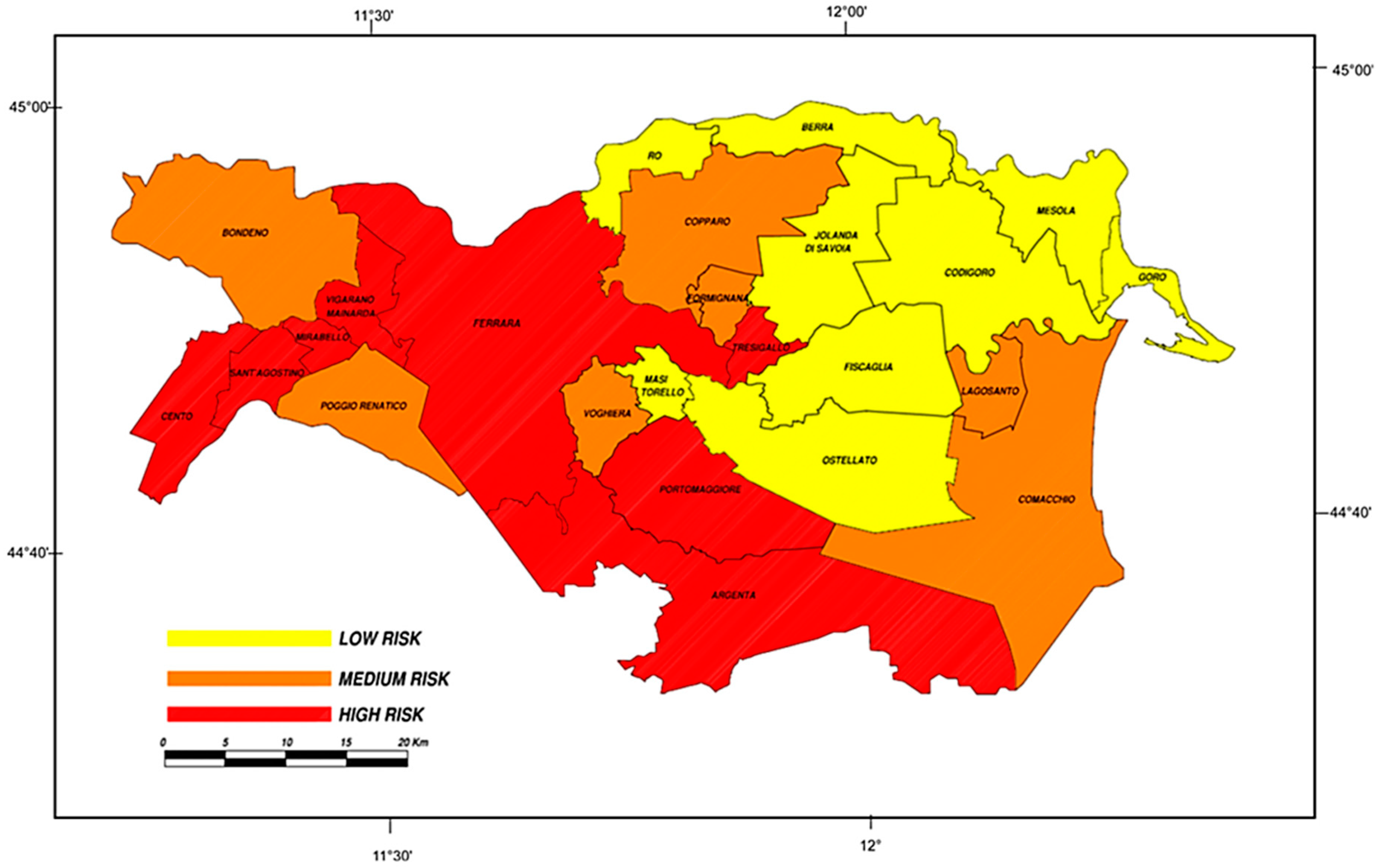

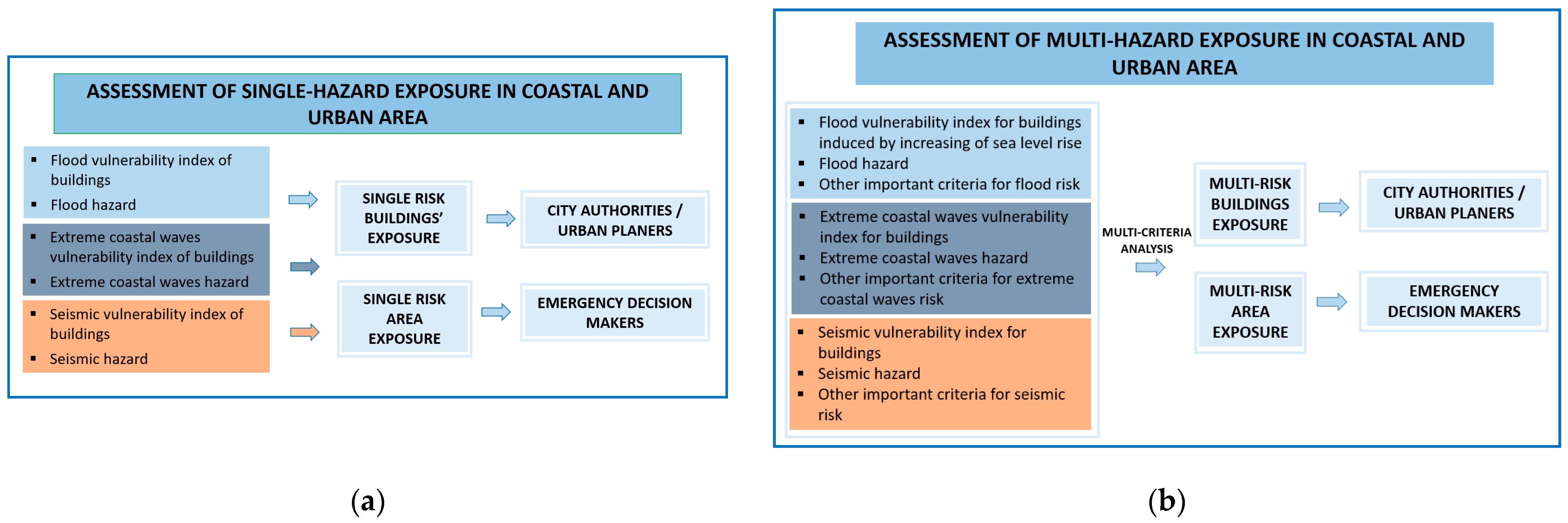

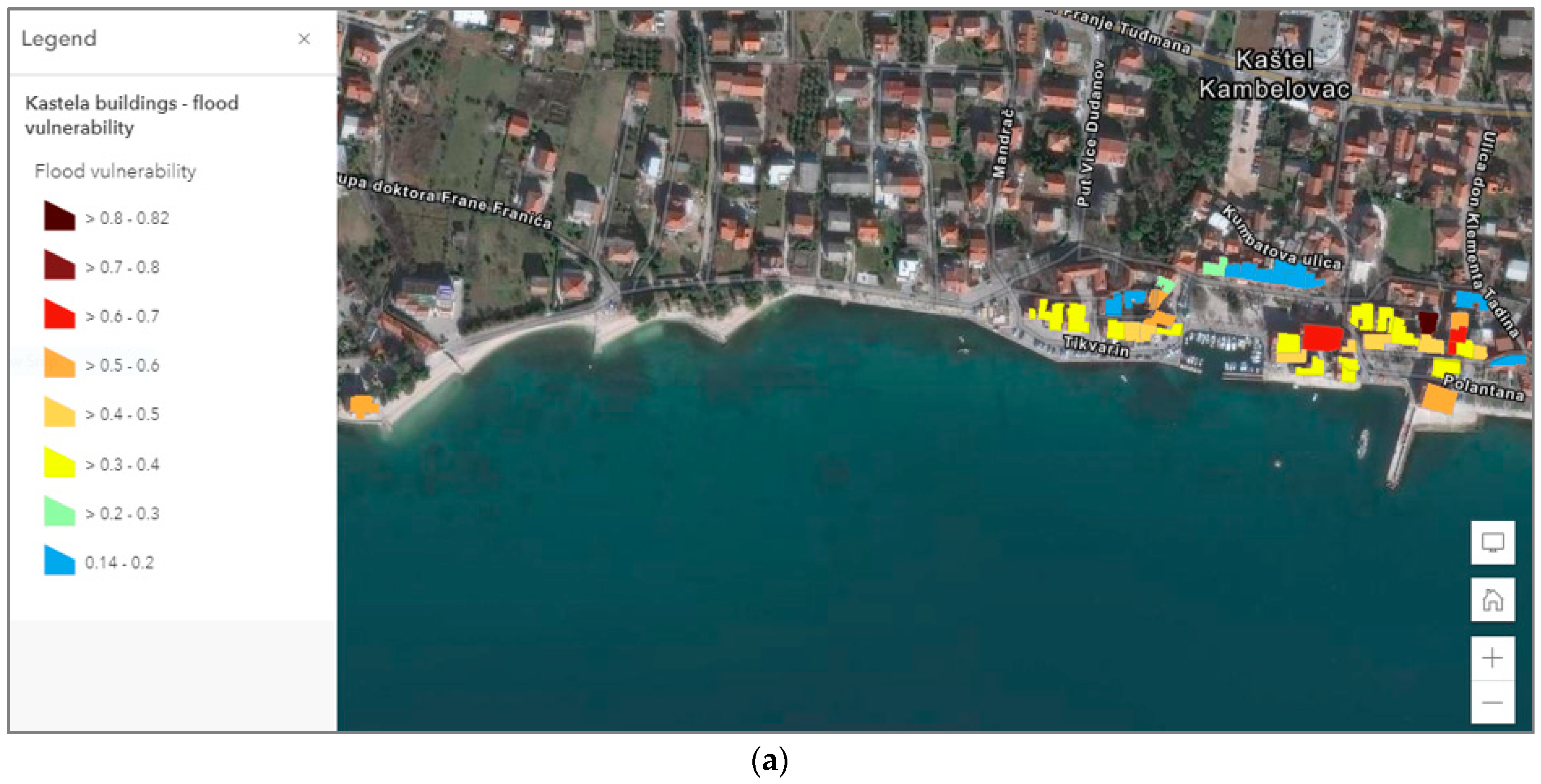
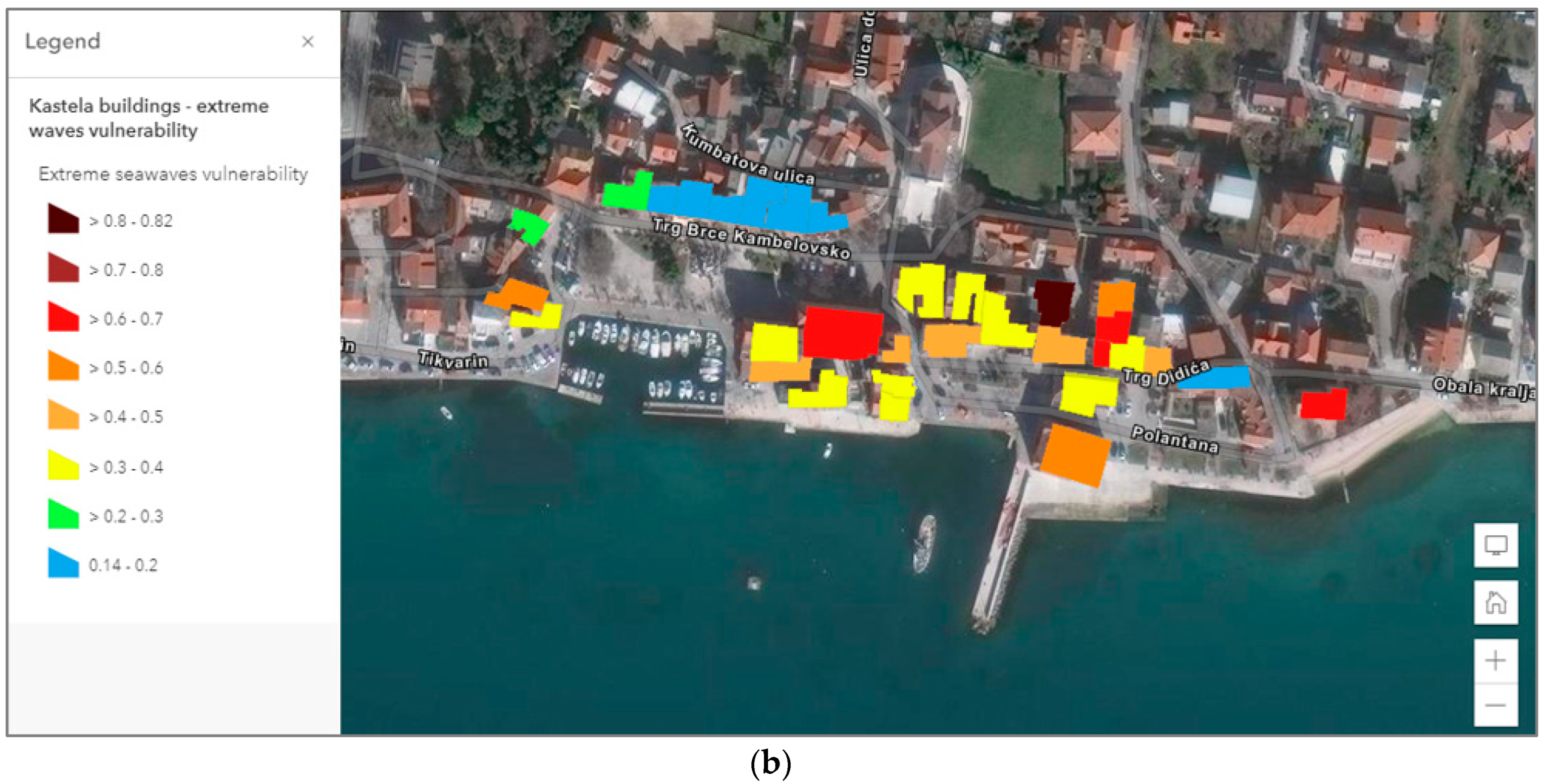
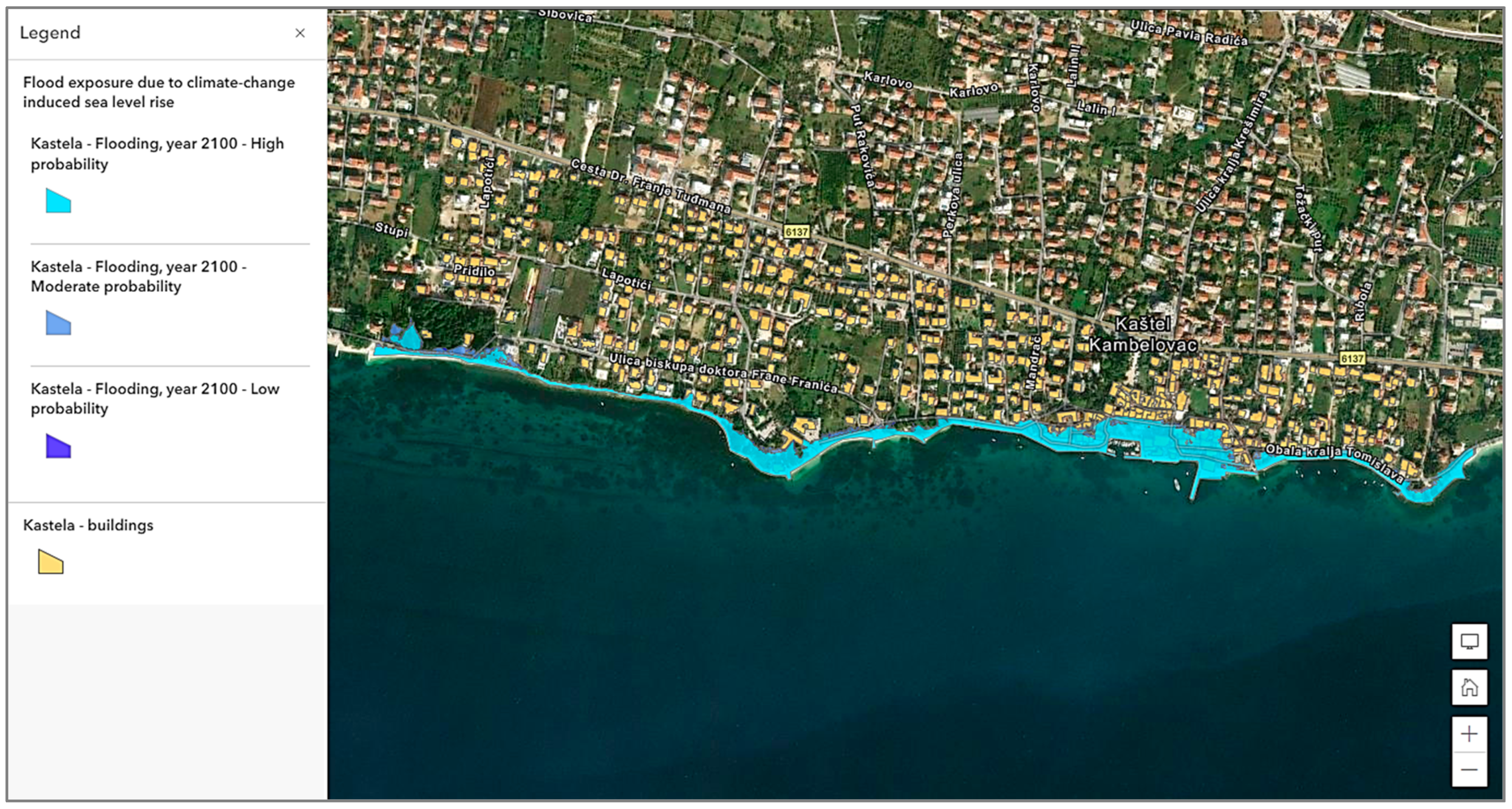



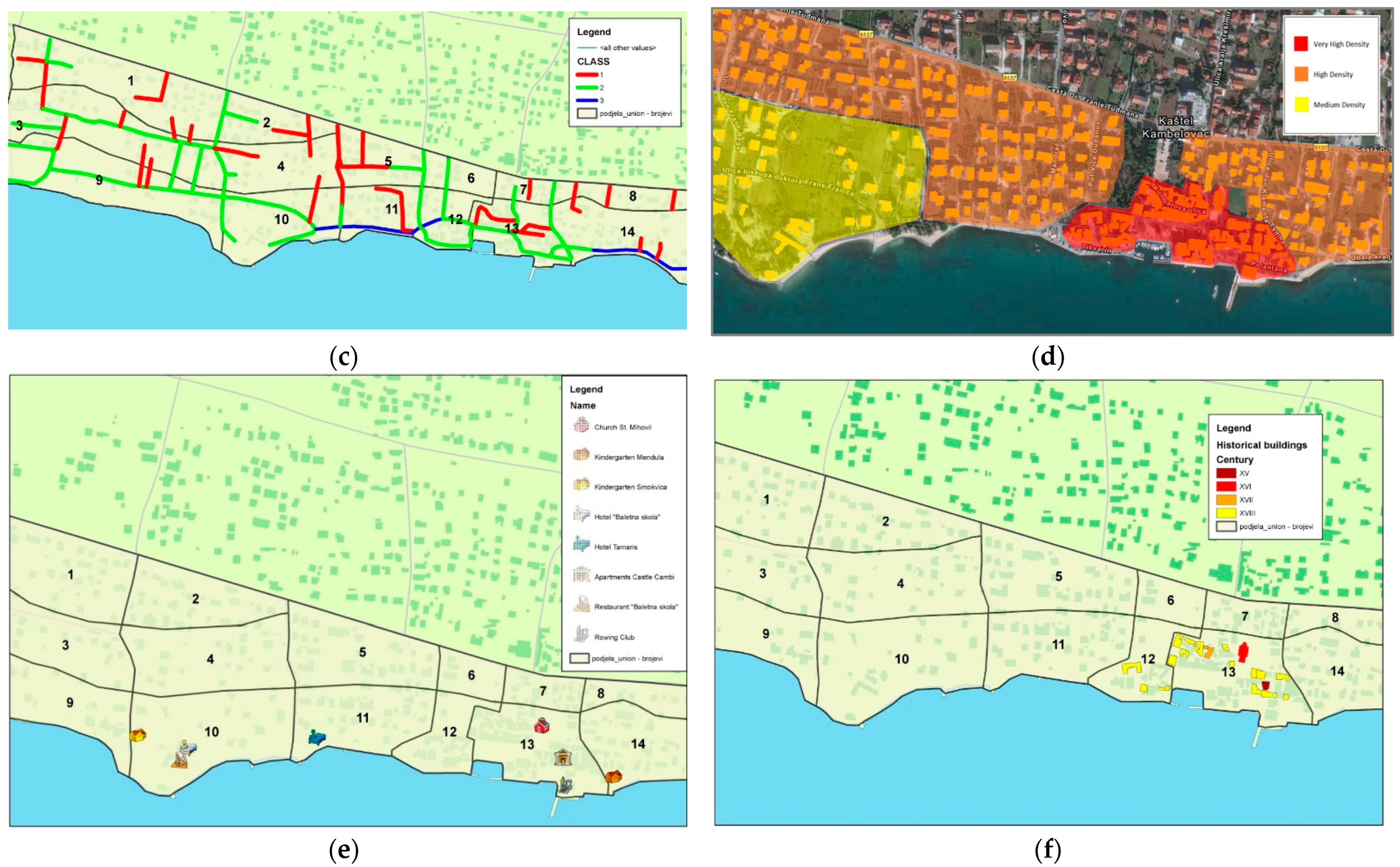
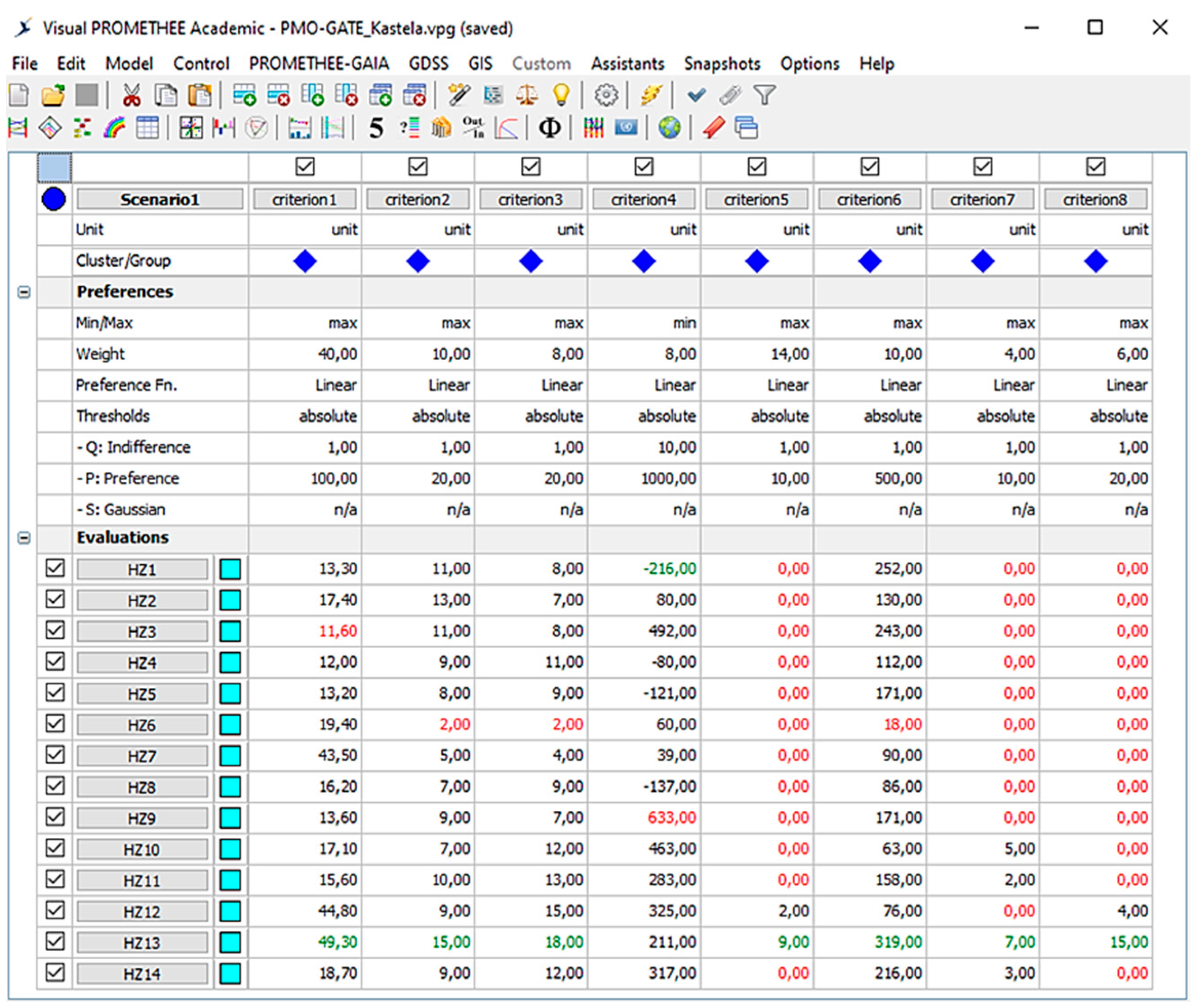
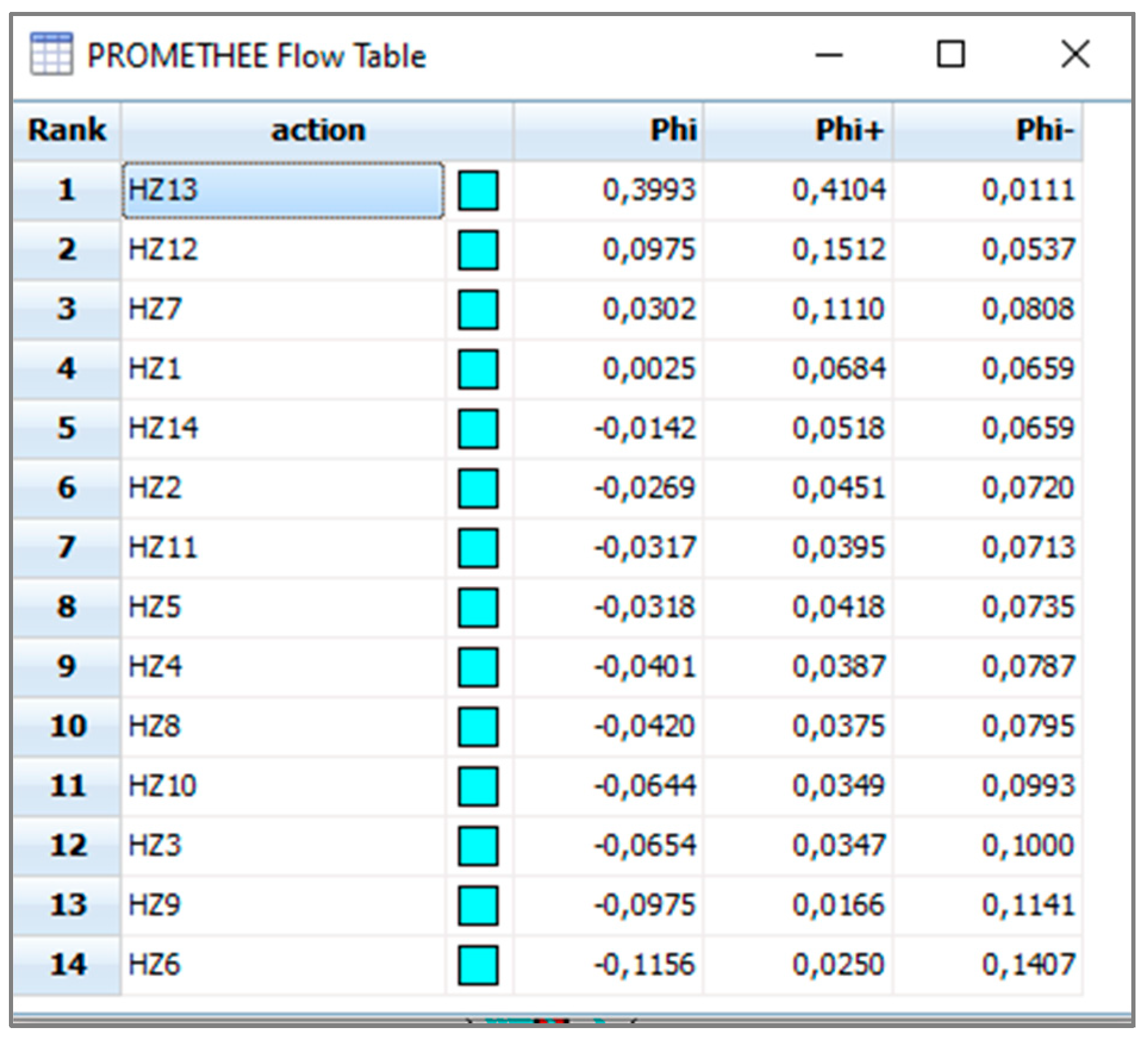
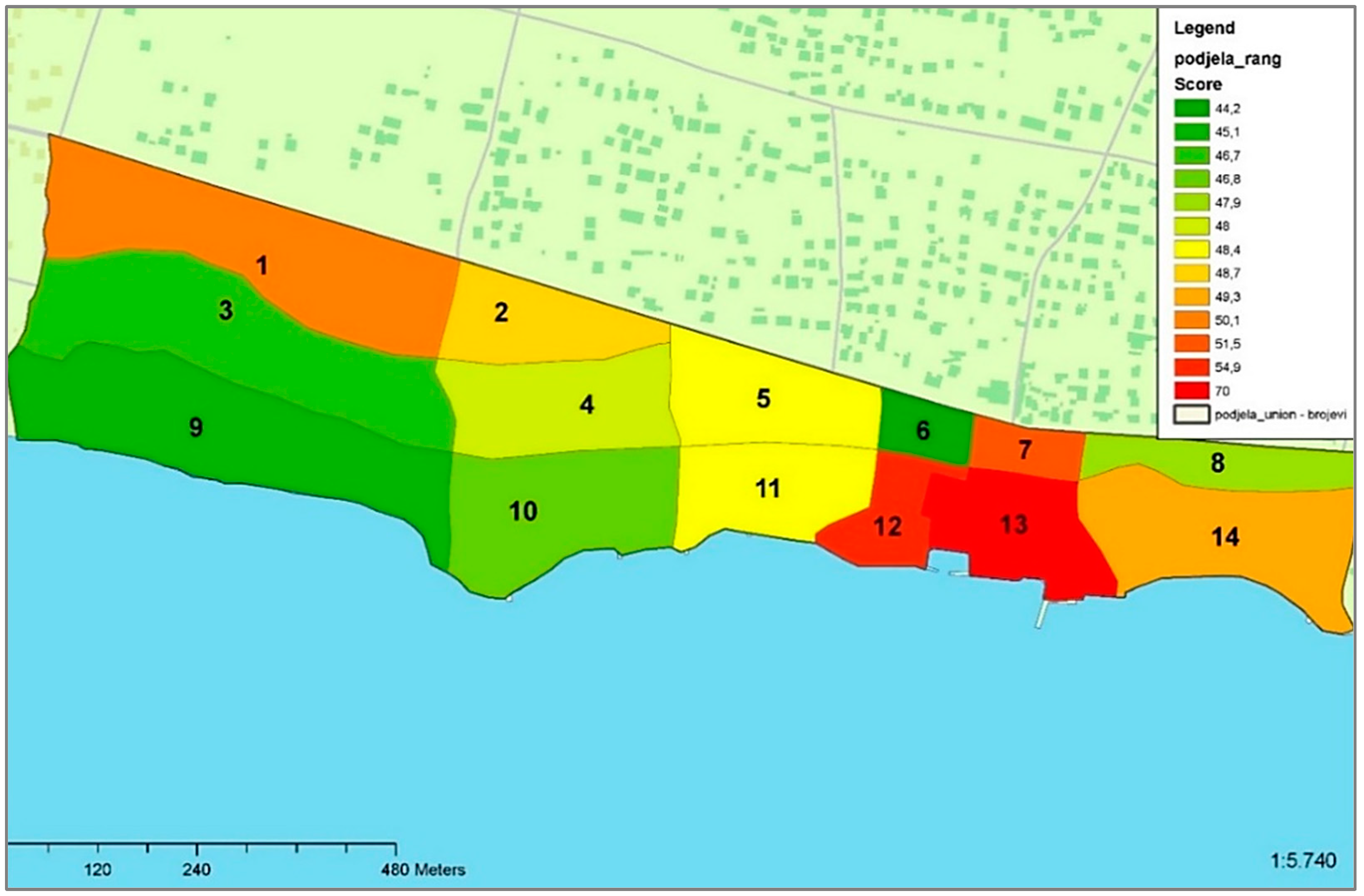

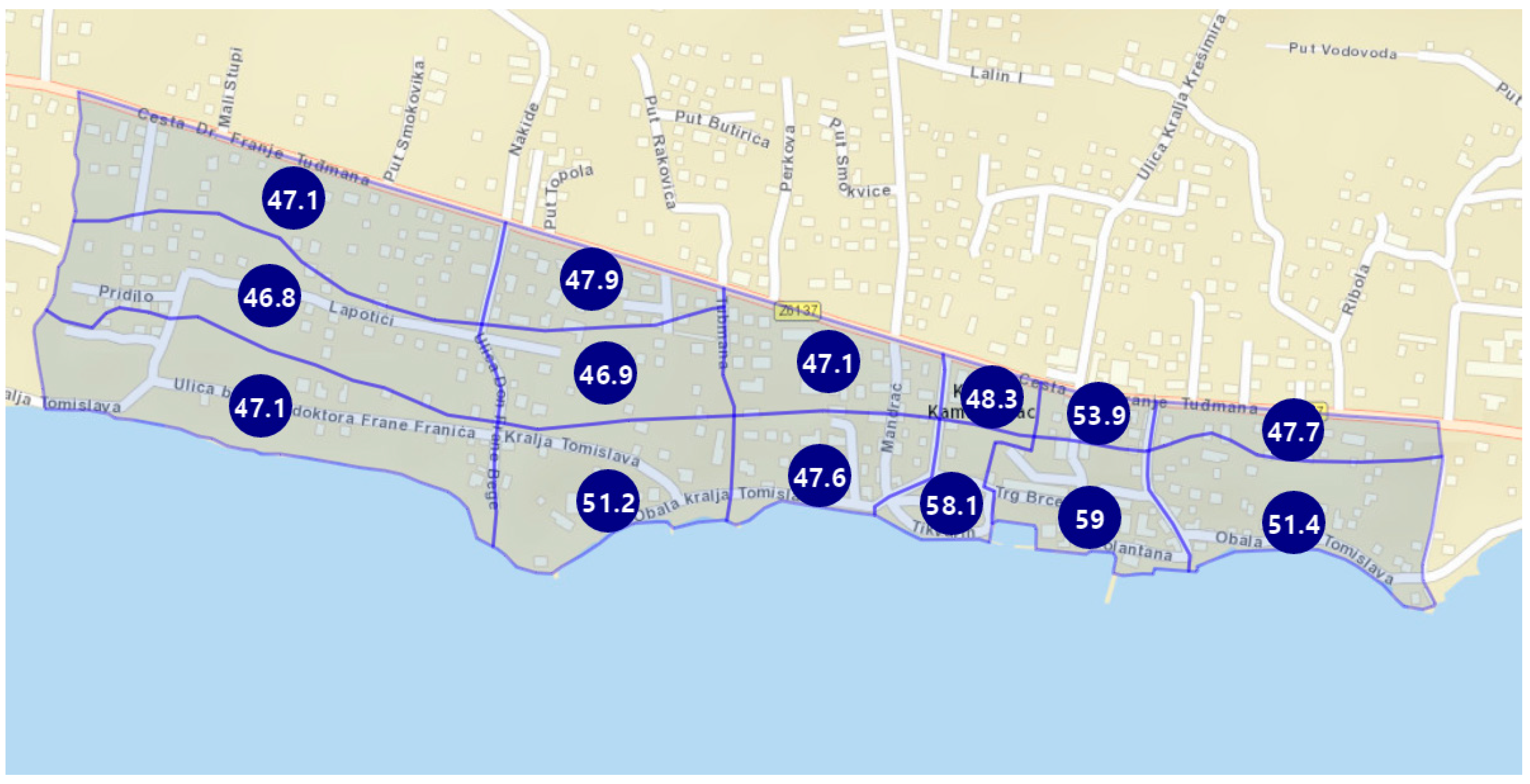


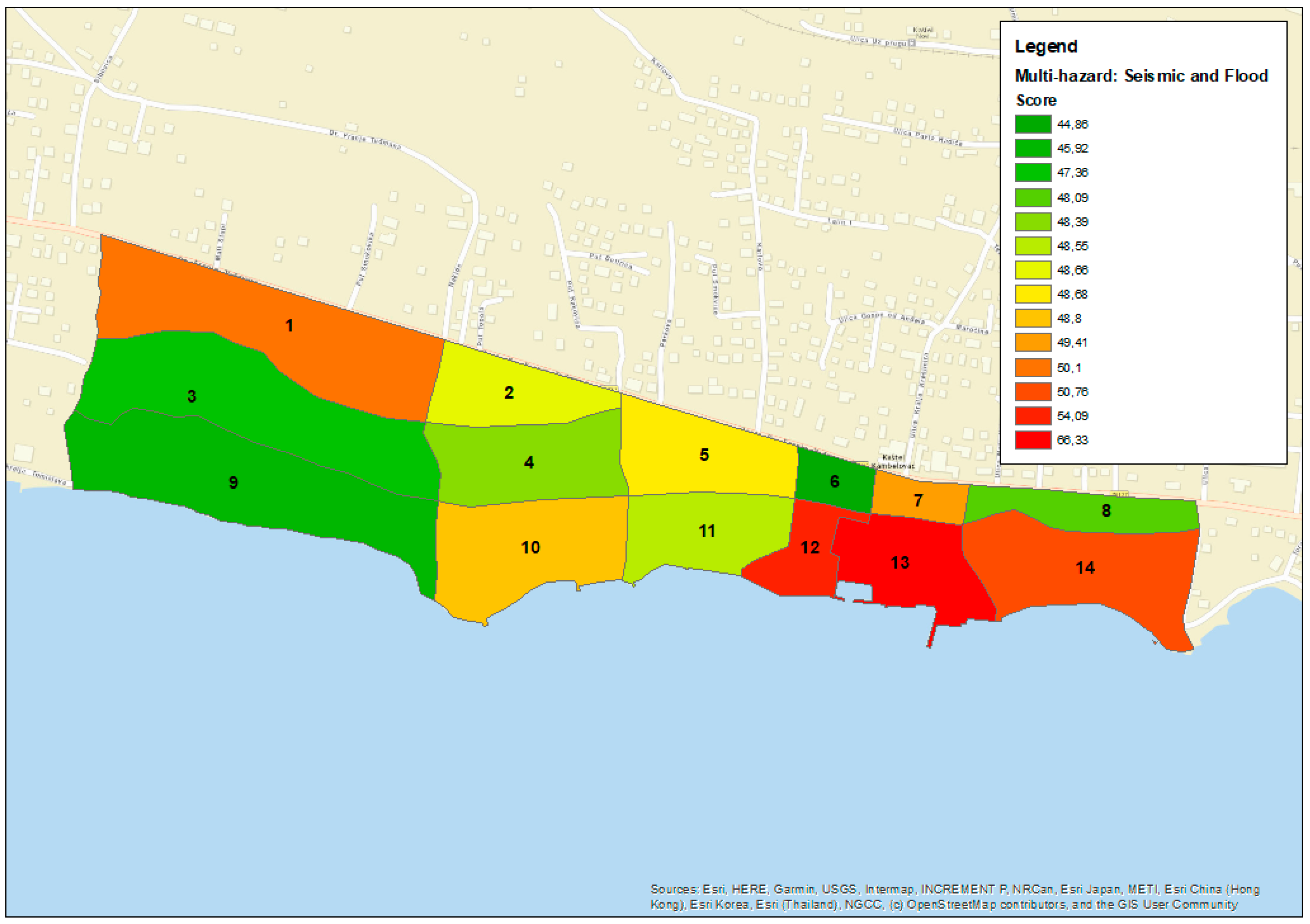
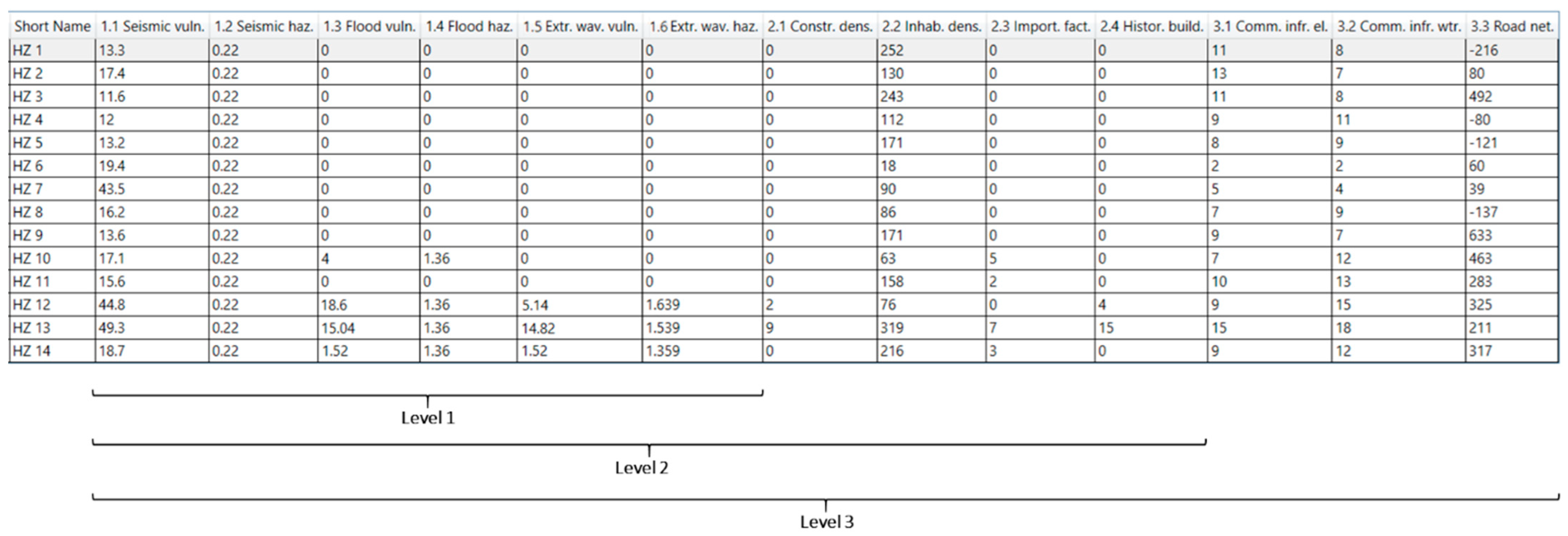

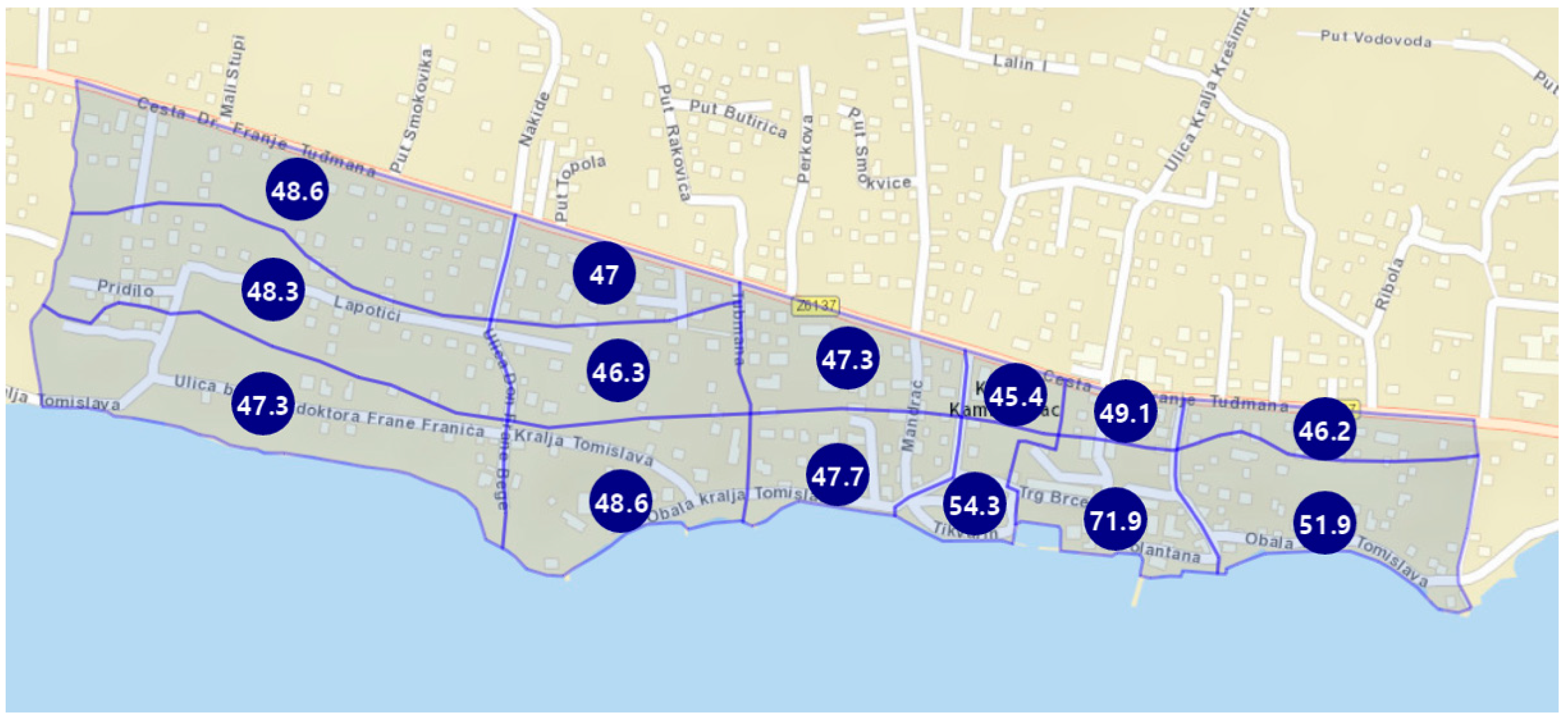
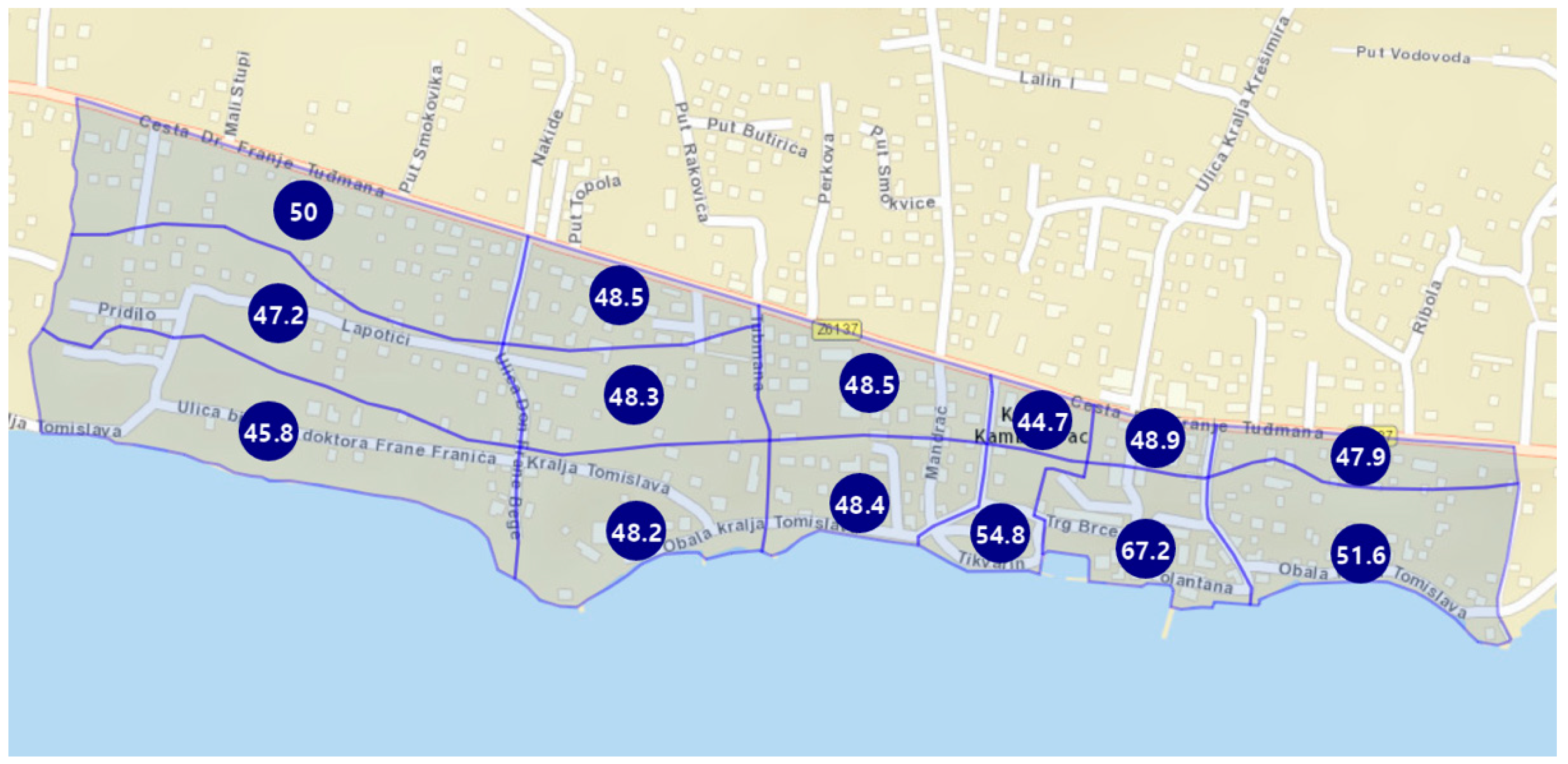

| Approach | Factors | Output | Source | |||
|---|---|---|---|---|---|---|
| Frequency | Intensity | Vulnerability | Other | |||
| Single hazard | Yes | No | No | Damage | Risk | Di Mauro et al. [6] |
| Multi-hazard | Yes | Yes | Yes | Coping capacity | Risk | Fleischhauer et al. [7] |
| Multi-hazard | No | Yes | Yes | Coping capacity | Integrated risk | Greiving et al. [5] |
| Single hazard | Yes | Yes | No | No | Risk | Kunz et al. [8] |
| Multi-hazard | Yes | Yes | Yes | Consequence (loss) | Risk | Liu et al. [9] |
| Multi-hazard | Yes | No | No | Aggregated losses | Risk | Mignan et al. [10] |
| Single hazard | No | No | Yes | Hazard exposure, Exposed value | Risk index | Munich Re Group [11] |
| Single hazard | Yes | Yes | No | Area impact | Hazard score | Odeh Engineers, Inc. [12] |
| Multi-hazard | Yes | Yes | Yes | Elements at risk, Temporal/Spatial probability | Risk | Van Westen [13] |
| Homogenous Zone (HZ) | Area (m2) | Number of Buildings | Seismic Vulnerability Index of Homogenous Zone |
|---|---|---|---|
| HZ1 | 58.627 | 56 | 0.133 |
| HZ2 | 21.865 | 29 | 0.174 |
| HZ3 | 57.189 | 54 | 0.116 |
| HZ4 | 30.925 | 25 | 0.120 |
| HZ5 | 26.972 | 38 | 0.132 |
| HZ6 | 7.763 | 4 | 0.194 |
| HZ7 | 7.767 | 20 | 0.435 |
| HZ8 | 16.168 | 19 | 0.162 |
| HZ9 | 60.068 | 38 | 0.136 |
| HZ10 | 38.133 | 14 | 0.171 |
| HZ11 | 24.972 | 35 | 0.156 |
| HZ12 | 12.696 | 17 | 0.448 |
| HZ13 | 24.903 | 71 | 0.493 |
| HZ14 | 40.782 | 48 | 0.187 |
| Level | Combined Seismic-Flood Risk: Scenario S-F | Combined Seismic-Flood-Extreme Waves Risk: Scenario S-F-EW |
|---|---|---|
| Level 1 criteria | Seismic hazard (1.1) Seismic vulnerability (1.2) Flood hazard (1.3) Flood vulnerability (1.4) | Seismic hazard (1.1) Seismic vulnerability (1.2) Flood hazard (1.3) Flood vulnerability (1.4) Extreme waves hazard (1.5) Extreme waves vulnerability (1.6) |
| Level 2 criteria | Seismic hazard (1.1) Seismic vulnerability (1.2) Flood hazard (1.3) Flood vulnerability (1.4) Construction density (2.1) Inhabitation density (2.2) Importance factor (2.3) Historical buildings (2.4) | Seismic hazard (1.1) Seismic vulnerability (1.2) Flood hazard (1.3) Flood vulnerability (1.4) Extreme waves hazard (1.5) Extreme waves vulnerability (1.6) Construction density (2.1) Inhabitation density (2.2) Importance factor (2.3) Historical buildings (2.4) |
| Level 3 criteria | Seismic hazard (1.1) Seismic vulnerability (1.2) Flood hazard (1.3) Flood vulnerability (1.4) Construction density (2.1) Inhabitation density (2.2) Importance factor (2.3) Historical buildings (2.4) Electrical infrastructure (3.1) Water supply infrastructure (3.2) Road network (3.3) | Seismic hazard (1.1) Seismic vulnerability (1.2) Flood hazard (1.3) Flood vulnerability (1.4) Extreme waves hazard (1.5) Extreme waves vulnerability (1.6) Construction density (2.1) Inhabitation density (2.2) Importance factor (2.3) Historical buildings (2.4) Electrical infrastructure (3.1) Water supply infrastructure (3.2) Road network (3.3) |
| Criteria Group | Group Weight | Criteria | Criteria Weight |
|---|---|---|---|
| Main criteria | 50% | Seismic hazard (1.1) | 21.7% |
| Seismic vulnerability (1.2) | 21.7% | ||
| Flood hazard (1.3) | 3.3% | ||
| Flood vulnerability (1.4) | 3.3% | ||
| Additional criteria (n—number of additional criteria) | 50% | Construction density (2.1) | 50/n = 12.5% |
| Inhabitation density (2.2) | 50/n = 12.5% | ||
| Importance factor (2.3) | 50/n = 12.5% | ||
| Historical buildings (2.4) | 50/n = 12.5% |
| Criteria Group | Group Weight | Criteria | Criteria Weight |
|---|---|---|---|
| Main criteria | 50% | Seismic hazard (1.1) | 19.5% |
| Seismic vulnerability (1.2) | 19.5% | ||
| Flood hazard (1.3) | 2.5% | ||
| Flood vulnerability (1.4) | 2.5% | ||
| Extreme waves hazard (1.5) | 3.0% | ||
| Extreme waves vulnerability (1.6) | 3.0% | ||
| Additional criteria (n—number of additional criteria) | 50% | Construction density (2.1) | 50/n = 12.5% |
| Inhabitation density (2.2) | 50/n = 12.5% | ||
| Importance factor (2.3) | 50/n = 12.5% | ||
| Historical buildings (2.4) | 50/n = 12.5% |
Publisher’s Note: MDPI stays neutral with regard to jurisdictional claims in published maps and institutional affiliations. |
© 2022 by the authors. Licensee MDPI, Basel, Switzerland. This article is an open access article distributed under the terms and conditions of the Creative Commons Attribution (CC BY) license (https://creativecommons.org/licenses/by/4.0/).
Share and Cite
Mladineo, N.; Mladineo, M.; Benvenuti, E.; Kekez, T.; Nikolić, Ž. Methodology for the Assessment of Multi-Hazard Risk in Urban Homogenous Zones. Appl. Sci. 2022, 12, 12843. https://doi.org/10.3390/app122412843
Mladineo N, Mladineo M, Benvenuti E, Kekez T, Nikolić Ž. Methodology for the Assessment of Multi-Hazard Risk in Urban Homogenous Zones. Applied Sciences. 2022; 12(24):12843. https://doi.org/10.3390/app122412843
Chicago/Turabian StyleMladineo, Nenad, Marko Mladineo, Elena Benvenuti, Toni Kekez, and Željana Nikolić. 2022. "Methodology for the Assessment of Multi-Hazard Risk in Urban Homogenous Zones" Applied Sciences 12, no. 24: 12843. https://doi.org/10.3390/app122412843






